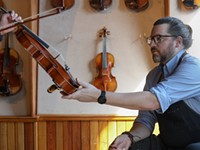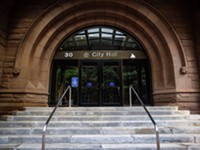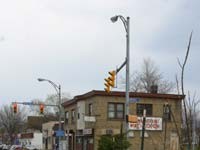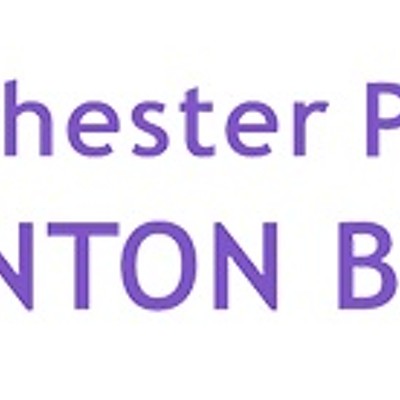[
{
"name": "500x250 Ad",
"insertPoint": "5",
"component": "15667920",
"parentWrapperClass": "",
"requiredCountToDisplay": "1"
}
]
Crime. Poverty. Drugs. To talk about the problems facing certain areas in the city of Rochester in 2004 is to talk about what has been eating steadily away at the community for years.
You might imagine the same conversation taking place in 2001. Or 2006.
Poverty and its baggage threaten the city's many vital neighborhoods and overshadow positive trends like the city's strong credit rating, housing market, and rising assessments. They also cast a pall over projects like the fast ferry, PaeTec Park, and a possible performing arts center.
Poverty is the womb, city officials say, from which a host of social problems are born. High concentrations of low-income housing lead to neighborhood decline and essentially turn certain sections of the city, especially in the northern districts, into a "poverty incubator" --- places people come to when they have nowhere else to go and which they leave as soon as their circumstances improve --- making way, says City Councilman Benjamin Douglas, for a fresh wave of lost souls.
"You really can't run a city without a certain level of wealth. You need a mix of incomes," says Douglas. "All the other things that we do will come to failure [without that]."
Douglas represents the city's Northeast District. Problems in the northern districts, say Douglas and Councilman Bob Stevenson, threaten the city as a whole. And impact city residents wherever they happen to pick up their mail.
In 2004, you can add another challenge to the city's list of ongoing structural problems --- lack of jobs, problems in the school system, drugs --- a budget gap nearing the $40 million mark. The gap is projected to climb to $95.5 million in five years.
The reasons for the gap are no big secret: a combination of escalating expenses and lost revenues.
The biggest drivers of the 2004-2005 gap are big increases in state pension costs --- something every municipality in New York State is facing. A number of county budget decisions also adversely affected the city, including cuts in public safety and additional charges for prisoners awaiting arraignment in Monroe County Jail. The county, too, will stop pavement marking services on some city streets. The move is expected to cost the city approximately $208,000 in 2004.
Retirement incentives are a big part of the longer-term projections, too. The $95.5 million gap projected for 2008-2009 is also based on flat property taxes, a 2 percent annual growth rate in the sales tax, increases in hospital and medical insurance, and other motivators.
The big issues in Councilman Bob Stevenson's Northwest District arehousing, police, and jobs.
"You give people jobs, the problems slowly disappear," he says. "You don't have people on welfare if you have jobs."
The Northwest District is home to about 90 percent of all the land zoned for manufacturing in the city. Right now, Stevenson says, vast stretches of that land stand vacant. Eastman Kodak, for example, has torn down more than 40 buildings as it has consistently downsized its workforce over the years.
"Basically, we're the engine that drives Rochester as far as manufacturing goes," he says. "Since we have all the land zoned manufacturing, I want to see it all used."
Stevenson is also pushing to have a west-side police station located in the present Maple section of the city, where it would be "somewhat central to the whole west side." The city is looking at combining its six stations: Maple, Genesee, Highland, Goodman, Clinton and downtown, into two stations on the east and west sides of the city.
Part of Maple is in the city's infamous Crescent --- a high-crime area that curves through parts of southwest, northwest, and northeast Rochester.
Crime and poverty go hand in hand, Stevenson says. The only way to eliminate the city's lucrative drug trade is to eliminate the profit, he says.
"Is there a war? No. We've lost that. We can't keep up with the demand. There's so much money to be made, easily, in narcotics," he says. "We're spending more on public safety than we collect in taxes every year --- $7 million more."
A minimum of $34 million of illegal drug money passes through the city of Rochester every year, Stevenson says. He adds he's not necessarily talking about legalization.
"I do know one thing: We can put a person through rehab for $18,600 a year. It costs about $30,000 to put a person in jail for about a year," he says. "We just can't keep spinning our wheels."
Dilapidated housing in the southern part of his district is another problem, Stevenson says. The city has been acquiring beat-up properties through foreclosure or by purchasing at fair market value and using a combination of city and federal funds. On Fulton Avenue, for example, the city bought and demolished 51 properties. More than 140 units were replaced with about 57, mostly single-family homes. New lights, sidewalks, and curbs were added.
"The lighting is beautiful," Stevenson says. "You can walk down there and read a newspaper the full length of Fulton Avenue now."
Stevenson would like other streets to get similar makeovers, including Emerson, Locust, and Ravine.
Housing is a major issue for Douglas, who says that "creeping blight" threatens even healthy areas of the city.
"You got people that are feeling pretty much stuck in a sense that they uphold strong neighborhood values, they keep their homes up, but things around them have not stayed at [the] level that they were 20 years ago," he says.
Douglas blames the high concentration of poverty mostly on absentee landlords, who have converted single-family homes into multi-family homes. They're just "cutting up" existing space, he says, and packing people in --- building a "bigger and better ghetto."
"It was a disease that had to be stemmed. Not just for the Northeast, but for the whole city," he says. "The city has gradually been putting policies in place, programs and incentives to homeowners who buy those properties to re-convert them back to single homes."
Deconcentrating poverty will reduce crime, Douglas says, although he believes the perception of crime in the city is worse than the reality. Ninety percent of the city's murders last year, he says, took place in the Crescent. The Crescent is also home to most of Rochester's gang activity, he says.
At 57, Rochester's 2003 murder rate was a six-year high, but at least one criminal justice expert is hopeful it was a one-year blip.
"I don't think there's anybody who's doing more to address the serious crime problem than the Rochester Police Department," says John Klofas, professor of criminal justice at RIT. "They really have done an enormous amount."
The city, to cite one example, has strengthened its relationships with local and federal prosecutors and probation and parole officers, Klofas says, to build solid cases against violators. The city has also engaged David Kennedy, a researcher from the Kennedy School of Government at Harvard, to implement a deterrent program that has been successful in Boston. The program identifies individuals "who might be involved" with serious crimes, Klofas says. Representatives from all areas of the criminal justice system meet with these individuals to warn them what they would face if arrested.
Cities that have seen substantial drop-offs in the homicide rate have worked comprehensively over a number of years before the decline showed up, Klofas says. New York City, for example, went from 2,000 homicides in 1992 to 587 in 2002.
"We have not seen that yet, but I think we're doing all the sorts of things that ought to produce that," he says. "When it does show up, it shows up as a fairly significant, rapid decline."
If the pattern holds, Klofas says, Rochester's hard work is due for a payoff.
"Certainly everybody's hoping that," he says.
Speaking of City, neighborhoods
-

Sought-after sounds at Payton Violins
May 5, 2023 -

Council approves Rochester 2034 plan
Nov 12, 2019 -

CITY to end political endorsements
Oct 22, 2019 - More »
Latest in News
More by Christine Carrie Fien
-

Building up
Mar 29, 2017 -

Hetsko's heart
Mar 15, 2017 -

Squeezing starts at GateHouse-owned Daily Record and RBJ
Feb 28, 2017 - More »
More by Christine Carrie Fien (FORMER)
-

Sticking it to the 19th Ward
Apr 21, 2004 -
After Amo
Apr 14, 2004 -
Of bonds, bridges, and bravado
Apr 14, 2004 - More »






